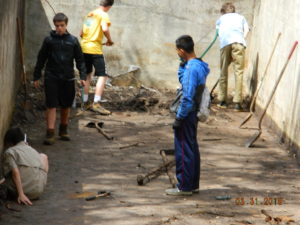 Fort Caswell Rifle Range experienced a very busy week. Then the exciting news arrived that the 1918 Fort Caswell Rifle Range was now designated a national WWI Centennial Memorial and suddenly there were many items on the To Do list.
Fort Caswell Rifle Range experienced a very busy week. Then the exciting news arrived that the 1918 Fort Caswell Rifle Range was now designated a national WWI Centennial Memorial and suddenly there were many items on the To Do list.
A quick recap…
 Friday and Saturday, March 30-31, Ethan Pannkuk arrived to complete his Eagle Scout Service Project. He and some family, friends, and fellow Scouts from Troop 210 in Carolina Beach worked for two days to clear the floor of the target pit and remove roots, digging and clearing the dirt from behind the north wall to examine the footer, and begin the effort to straighten the wall. Two posts cover this work: Day 1 and Day 2. Local newspapers will feature the work later; copies will be found on the News section of the website when they have been published.
Friday and Saturday, March 30-31, Ethan Pannkuk arrived to complete his Eagle Scout Service Project. He and some family, friends, and fellow Scouts from Troop 210 in Carolina Beach worked for two days to clear the floor of the target pit and remove roots, digging and clearing the dirt from behind the north wall to examine the footer, and begin the effort to straighten the wall. Two posts cover this work: Day 1 and Day 2. Local newspapers will feature the work later; copies will be found on the News section of the website when they have been published.
On Tuesday, April 3, a visitor from the State Historic Preservation Office in Raleigh inspected the rifle range. The Friends of Fort Rifle Range will continue with stabilization efforts as advised.

 Helen and Bob Radcliffe have been hard at work on two projects. They created a standing wooden monument with thermometer to show fundraising progress.
Helen and Bob Radcliffe have been hard at work on two projects. They created a standing wooden monument with thermometer to show fundraising progress.
 Helen worked on beautiful themed baskets that will be available for raffle at the Derby fundraiser on Saturday, May 5.
Helen worked on beautiful themed baskets that will be available for raffle at the Derby fundraiser on Saturday, May 5.
Buy your tickets now!
The clubhouse can only accommodate a limited number. Volunteers are still needed.
Tabletop horses are available for sale! Become an “owner” of the horse and win when your horse does. See Derby fundraiser webpage.

 Banners were installed at the clubhouse to announce the Derby fundraiser.
Banners were installed at the clubhouse to announce the Derby fundraiser.
An additional banner was ordered using a poster from the Library of Congress with the insignias of combat units during World War I. This poster was used by the recruiting office in 1919. You can see the poster and link on the World War I Army/Marine Division Roster webpage.
The photo shown is Norm Sprinthall pointing at the insignia of the 26th Division, the unit his father served in during WWI. Read more about Norm and Lois Sprinthall’s donation in honor of his father, Sgt Archie Sprinthall. Sgt Sprinthall is also included on the WWI Wall of Honor, as well as his fellow soldiers who didn’t return home.
Photo by Christine Urick
 Friday, April 6, the Commemoration of the Anniversary of United State’s entry into WWI was held. It was a beautiful day. The recitation of honored Brunswick County WWI veterans was touching. Read the DAR Brunswick Chapter blog post.
Friday, April 6, the Commemoration of the Anniversary of United State’s entry into WWI was held. It was a beautiful day. The recitation of honored Brunswick County WWI veterans was touching. Read the DAR Brunswick Chapter blog post.
 Also on Friday, the announcement was made by The United States World War I Centennial Commission and The Pritzker Military Museum & Library – –
Also on Friday, the announcement was made by The United States World War I Centennial Commission and The Pritzker Military Museum & Library – –
The 1918 Fort Caswell Rifle Range had joined prestigious WWI memorials and landmarks such as Chicago’s “Soldier Field” and Washington, D.C.’s “National World War I Memorial at Pershing Park”.
The 1918 Fort Caswell Rifle Range is now designated as one of only 100 national WWI Centennial Memorials.
It must be said again and again before the Friends of Fort Caswell Rifle Range can finally believe it. The 100 designated memorials must be checked each day to ensure the 1918 Fort Caswell Rifle Range is still listed.
This was the culmination of many months of writing, reviewing, revising, and hand-wringing to create a proposal that would fully capture the dedication required for the seven years of work to date. The Fort Caswell Rifle Range receives not only the national designation, but also a grant “towards the restoration, conservation and maintenance of local historical treasures.”
It will result in national attention and publicity for the rifle range. More details will follow on possible podcasts, the award presentation, and publications. Official press release: FINAL 100 Cities/100 Memorials Press Release for Official World War I Centennial Memorials
The U.S. World War One Centennial Commission was established by the World War One Centennial Commission Act, part of Public Law 112-272 passed by the 112th Congress and signed by President Obama on January 16, 2013. The Commission is responsible for planning, developing, and executing programs, projects, and activities to commemorate the centennial of World War One. All living presidents serve as Honorary Chairs. Read more on the webpage at www.worldwar1centennial.org







































You must be logged in to post a comment.